

Wanderfound
-
Posts
4,893 -
Joined
-
Last visited
Content Type
Profiles
Forums
Developer Articles
KSP2 Release Notes
Posts posted by Wanderfound
-
-
All stock, and specifically designed to lug Rockomax 64s. Manages it easily under old FAR; checking how it goes post-nerf as I type.
Hmmn. We have new-FAR issues. Might be worth keeping it to a half-full tank until the engineers get it sorted.
-
Care to suggest a specific craft, Rubisco? My spaceplanes get themselves into orbit neatly and cheaply, but they can just barely get a 1 ton satellite into orbit.
If it can't get a rockomax 32 (at minimum) into orbit in one trip, then really you're only saving kerbal currency at the expense of player time.
You might like this one: https://www.dropbox.com/s/jhgl6sva73ntcum/Kerbodyne%20D7%20Heavy.craft
All stock, and specifically designed to lug Rockomax 64s. Manages it easily under old FAR; checking how it goes post-nerf as I type.
-
I finally did it.
Congrats, BTW.

Careful, though; they're addictive...
-
Very simple solution.
Mount a couple (or six or so) seperatrons around your nose, oriented vertically.
Don't try to lift the nose by leverage on the gear, just *lift* the nose by rocket power!
Empty seperatrons weigh virtually nil, yet for a brief moment they will provide the energy needed to accomplish your runway rotation without stressing your wheels.
Rotation is not a problem. Lifting the nose is not a problem. The problem is the front gear (not the rear) collapsing when they're carrying ~100 ton of spaceplane down the runway at 110m/s.
The connection to lifting the nose was just a timing coincidence; I can get the same behaviour to occur without touching any controls except throttle.
-
The only thing that I can guess is that you have some kind of flex somewhere causing the gear to buckle due to the mass.
Yeah, it looks to be largely a mass issue. Adding another pair of gear to the front of the plane (also on pylons) delayed the wobble until about 130m/s (with a 65 ton payload; they're fine with a sensible load), which may be enough to get off the ground so long as I don't dawdle.
The main problem is that I'm trying to use fighter-plane landing gear on a C-17.
-
Quick question.
Which version of FAR are you running?
The latest version with the nerfed engines or the previous version 14.02?
I thought I had the latest version of FAR, v0.14; I re-downloaded all my mods after First Contract came out. Looking at their site right now, though, it looks like there's a v0.14.1, and the changelog mentions an engine nerf.
Updating now. How heavily did they cripple the turbojets and RAPIERs? May have to swap the outer pair for aerospikes...
-
That's very impressive Wanderfound - all the other spaceplanes I've seen with anything like that payload have had to rely on loads of mods and/or massive part-clipping, engines inside engines, 10 layers of wings, all that sort of thing. How have you managed that?
Creativity and time (I've been ill, nothing else to do).
Apart from Mechjeb, she's all stock parts, and the only part clipping is what you can get without using the debug menu (mostly just that there's a probe core hidden in the fuselage so that it can be flown as a drone). The only wing overlapping was what was necessary to get the wing shape I wanted; 95% of the wing surface is single layer.
The plane is essentially built like a tuning fork; despite appearances, the only thing connecting the back of it together is a lot of struts. The main inspiration was in realising that a pair of rotated type 2 fuselages would make a pretty decent open-air cargo bay. There's no roof or floor to it, which is handy as a lot of cargo loads protrude above and below. Cargo is secured via a docking port at the front of the bay and a mesh of struts coming from radial decouplers along the sides of the bay.
Power is a pair of turbojets plus four RAPIERs. With all six engines sucking air, it can climb vertically unloaded and at better than 60 degrees with a full bay. The final run before orbital lift is usually done on only the turbojets; there just isn't enough air at 30,000m to feed six engines.
Under FAR, she can crack Mach 5 at 30,000m and needs less than a minute of oxidising burn to get the apoapsis over 70km with a 30 ton cargo load (plus about thirty seconds for circularising). There's an abort system, emergency brakes for short runways, and enough spare weight capacity that adding further luxuries is no problem. I've only been using it for lifting orbital infrastructure so far, but it could be fun to try and land it on the Mun...
The craft file is at https://www.dropbox.com/s/jhgl6sva73...%20Heavy.craft (with Mechjeb removed, so it's 100% stock), and there are more screenshots at http://s1378.photobucket.com/user/craigmotbey/library/
-
-
Re: angling up. The rear gear is as low as it can be without risking bulky cargoes striking the tarmac during takeoff (it's an open-air cargo bay; no roof or floor, and the cargo is often big enough to protrude substantially from top and bottom). The front gear is as high as it can reasonably be; it's already mounted on structural pylons.
This is probably a large part of the problem, which I've attempted to deal with by a spiderweb of struts which obviously aren't doing the job.
-
Just got it into the air with 65 ton again. This time, the gear started to fail just before I started to lift the nose; it looks like it may be nothing to do with the initial lift, but instead just be failing when it hits a speed that coincidentally is around the same as the takeoff speed (110m/s in this case). I suspect the suspension may be doing some sort of pogoing thing which is sending the steering haywire, which in turn overstresses the gear. I'll post a closeup screenshot of all the gear when I can.
Regarding the tailstrike guards: the plane is designed to carry very heavy loads. In order to avoid having to redesign the aerodynamics every time I change the cargo, it is necessary that the cargo bay be on the centre of mass. This meant that I had the centre of mass further forward than I would normally prefer, which meant that my rearmost conventional gear needed to be brought forwards far enough that tailstrike became an issue.
It can safely take off without them, but you need to be careful, and when the cargo load gets truly ridiculous it's helpful to be able to just crank the nose up as hard as you can before you run out of runway. In extreme cases, you pivot off the tailstrike wheels in the last moment before takeoff. They're also handy for cushioning the shock on the rear gear when landing with a heavy load. The extra weight is trivial when dealing with a plane this size.
-
I have one simple answer.
Your landing gear are to far behind your CoM to rotate to take off.
This is why your gear are wobbling as soon as you try and lift the nose. You are lifting the nose and pushing the rear gear into the tarmac.
It takes off just fine with a 30 ton payload, and even with 70 it will take off on the one in three attempts that I get it up before the gear fail completely. The rearmost gear are mounted high, as tailstrike guards. They don't contact the ground until the nose is in the air.
The rear gear are fine. It's the front gear that are failing. CoM is bang in the middle of the plane.
-
You'd probably benefit from reading this post: http://forum.kerbalspaceprogram.com/threads/87753-Airplane-doesnt-fly-well?p=1302513&viewfull=1#post1302513
Short version: lift is drag. Drag wants to go backwards. Rear centre of lift = back of plane gets pulled backwards, keeping the front of the plane pointed to the front. Front centre of lift = front of plane gets pulled backwards, entertaining Kerbal screenshots happen.
-
Fun. Also pin-point accurate landings on the runway. And plane parts allow for better aesthetics imo. Going to the Mun is one thing, doing it in style is another.
Seconded.
Landing on the Mun is fun. Doing a VTOL landing on the Mun in a hypersonic spaceplane that looks like an F-15 is awesome.
I'd rather go to space in a sportscar than a truck.
-
As a launch vehicle you'll find it has a miniscule to negative payload capability. If you need a SSTO use a rocket, if you don't need a SSTO, use a rocket. If you want to use a jet first stage drop all the wasted mass of wings.
That's incredible mind-reading! You already know I'm going to say; spaceplanes are only useful for launching tiny loads from Kerbin to orbit. They're also fun for Laythe, of course, since it has an oxygen atmosphere. Everywhere else and for any payload over a tonne or two you're better off with a rocket (or a hoard of mods).
I beg to differ.
It can reach orbit carrying a 30 ton payload with plenty of spare fuel. It could do it with 70 ton if I could just figure out how to stop the landing gear from collapsing during takeoff...
-
Okay; I'm trying to test the limits of my heavy lift spaceplane. It can comfortably lift 30 tons to orbit, but I'm now pushing 70 ton. It can fly just fine with that amount of weight aboard; what it can't do is take off. No matter how much bracing I apply, the front gear wobble and then fail.
The weird thing is that they don't start wobbling until I begin to lift the nose. This doesn't make sense; if they're going to buckle, it should be when the weight is on them, not when I take it off.
Any ideas?
-
According to the J58 page on Wikipedia (blessed be the Font of All Knowledge) it's similar, but the KSP turbojet is still about 150% more powerful for its weight.
I can live with that; after all, the J58 is a fifty year old design.
-
NRAP for the win. Thanks, folks.
-
In KSP most of that doesn't apply because of how over powered the jet engines are in relation to the real world.
A great example is, the F-100 used on the F-16 Fighting Falcon only generates 129kn of thrust in afterburner. But the stock basic jet engine creates 140kn of thrust. And the turbojet creates almost double that of the F-100.
OTOH, when you're building spaceplanes, it's not unreasonable to assume that you're using top-line components. How does a Kerbal turbojet compare to something like an SR-71 engine?
-
With this request, and buzzboy's interesting submission, I've made two parts. One scoreboard with recovery counted, one without.
I welcome you to the contest, flyboys!
Thanks for the invite.

You may need to open it up to FAR, though; I doubt that there are any serious flyers using stock physics.
-
What are the parts that have the most mass for their size?
I'm trying to work out the maximum lifting capacity of my SSTO, but it's well within its weight capabilities when the cargo bay is chock-full of orange fuel tank. I need some small but heavy things that I can use to test the limits of it. Which Kerbal parts have the highest density?
-
So, I got a contract to test one of the big Kerbodyne engines. Unfortunately, I'm not really building any big rockets right now, so I couldn't just strap it on the bottom of something that was going up. Or maybe I could?
Introducing the Kerbodyne D7 Heavy Lifter:
Although the D7's cargo bay is typically filled with fuel tanks or space station segments, it occurred to me that something else might fit in there:
So it's off to the runway...
...and away we go.
Now, I know that I could just activate it without any fuel and complete the contract that way. But that wouldn't be very Kerbal, would it?
Whee!
-
Apparently bringing this feature back has had some negative side effects when another craft enters the physics bubble around KSC. Nothing like have your throttle adjusted for you when on final approach to the runway.

Yeah; that one has been bugging me. Fortunately turbojets spin up slowly enough that I can kill the throttle before it crashes the plane, but still...
-
Do you mind sharing your design? I've not had much luck or experience with space planes and this intrigues me.
In case anyone else is interested:
https://www.dropbox.com/s/jhgl6sva73ntcum/Kerbodyne%20D7%20Heavy.craft for the Kerbodyne D7 Heavy.
https://www.dropbox.com/s/o7z87n1i1zqlv3n/Kerbodyne%20Overshoot%20VTOL.craft for the Kerbodyne Overshoot.
All stock parts.
Both planes have abort systems, the D7 also has emergency brakes. The underpowered VTOL rockets on the Overshoot are for Mun landings; they shouldn't be used in atmosphere. The D7 Heavy can lug a full orange fuel tank; attach it to the docking port at the front of the cargo bay, put some radial decouplers along the sides of the bay and run lots of struts from the decouplers to the cargo. Watch the cargo as the plane drops onto the runway to check that it doesn't wobble too much. Keep the RCS off unless you need it.
-
Also, If I'm not mistaken dont the recovered parts yield less than 100% cashback?
If you land on KSC runway, you do indeed get 100% recovery (minus expended fuel). And because my spaceplanes are usually only burning oxidiser for a minute or two per flight, even the fuel bill is tiny.
Kerbal spaceplanes are outrageously cheap to fly. And the 100% recovery thing means that there's no need to economise (apart from crash risk). While everyone else has been working on stripped-back solid fuel budget lifters, I've been tooling around in tricked-out orbital sportscars.
The prototyping ain't cheap, however. I had half a million worth of heavy spaceplanes disintegrate on takeoff before I got the landing gear issues sorted. Fun to watch, though.






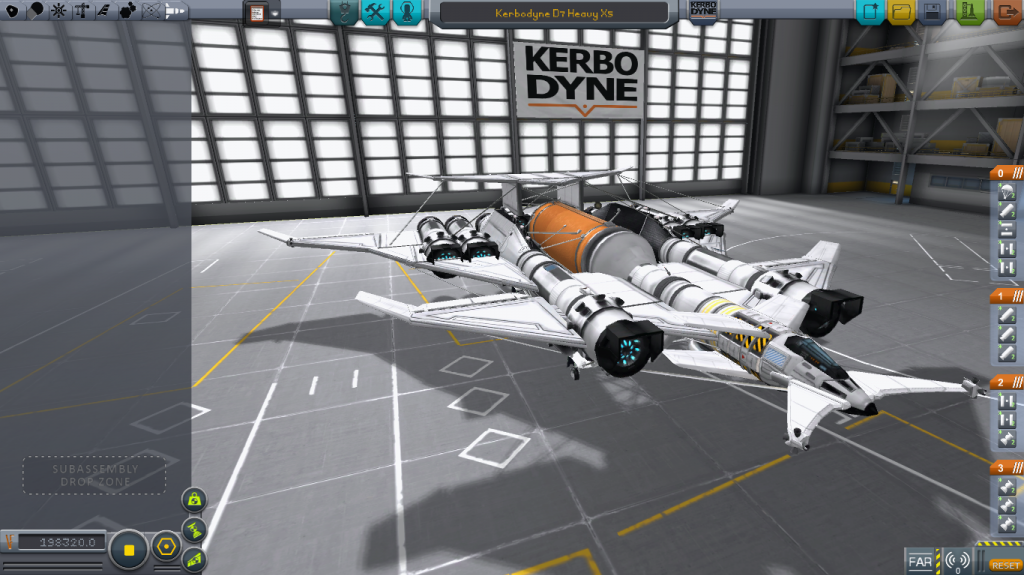

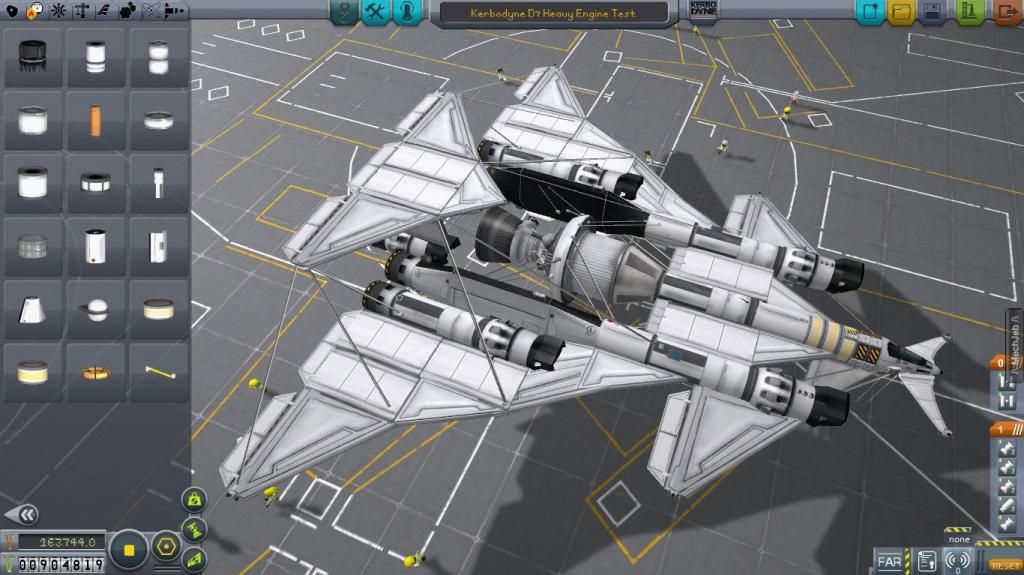
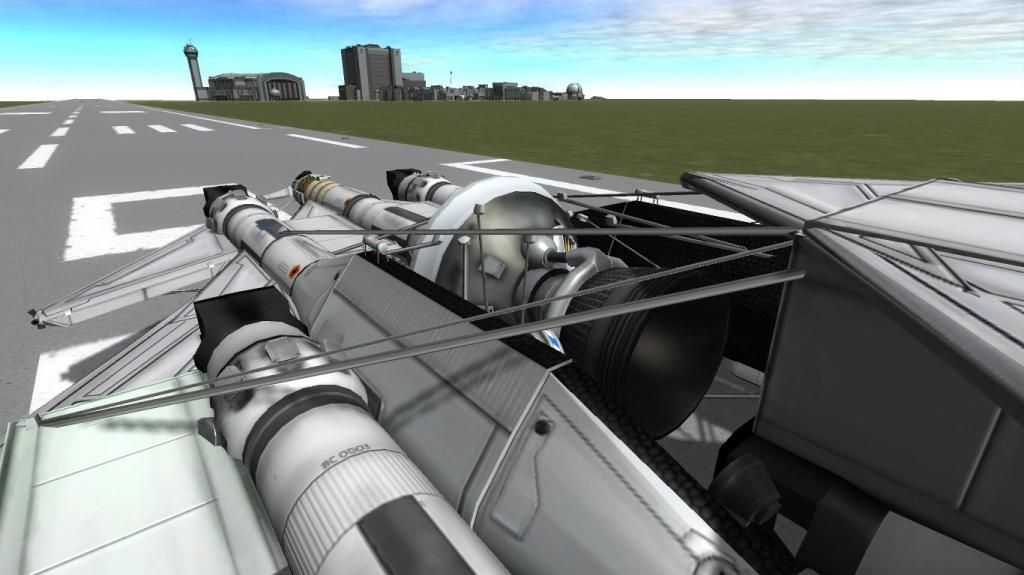
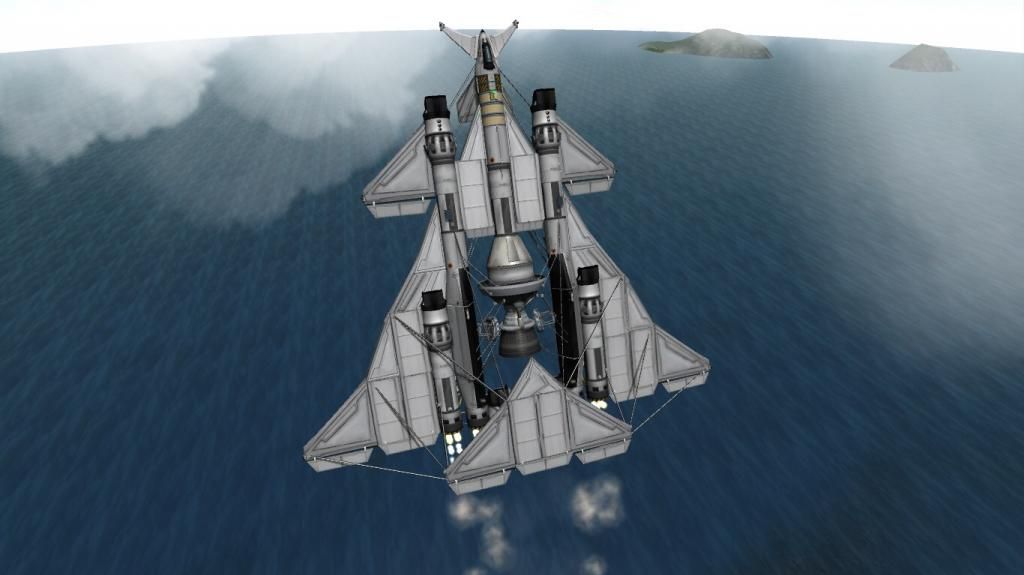
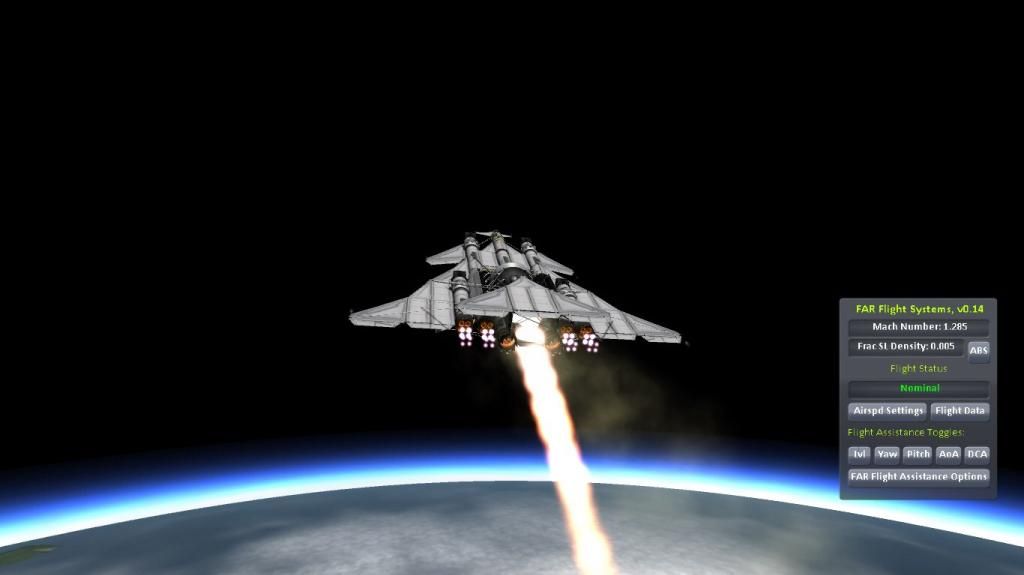
Tweaked aerodynamics ?
in KSP1 Suggestions & Development Discussion
Posted
You're missing some creative options if you do it that way. Place your Sepratrons right and you can make the boosters do ballet as they fall...
(think Sepratron mounting angles, opposed rockets and spins)